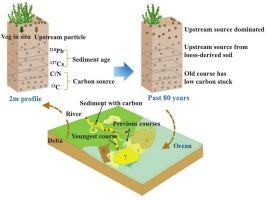黄河三角洲河道变化频繁导致沉积物有机碳储量低
IF 5.7
1区 农林科学
Q1 GEOSCIENCES, MULTIDISCIPLINARY
引用次数: 0
摘要
河流三角洲的沿海冲积平原可以通过掩埋高地沉积物和前表土来储存大量的碳。黄河三角洲的上游泥沙不断淤积,河道不断移动,为研究这一问题提供了一个独特的案例。我们沿着沉积物序列收集了5个2米的土壤岩心,反映了80年的沉积和河道变化。通过对土壤有机碳储量和来源的分析,发现老河道的有机碳含量低于新河道。除地表外,土壤有机碳含量普遍较低。上游来源的有机碳对有机碳储量的贡献大于当地植被,特别是在较年轻的沉积物中。所有沉积物均表现出高无机碳和碱性条件,表明高原黄土底土是主要的沉积物来源。这些底土有机碳含量低,风化作用弱,表明侵蚀迅速,上游陆地碳循环退化。虽然三角洲环境可以保护沉积的碳,但我们的研究结果强调,由于c耗尽物质的输入,SOC的增加有限。因此,水土保持不仅在三角洲,而且在其易受侵蚀的高地也是至关重要的。本文章由计算机程序翻译,如有差异,请以英文原文为准。

Low organic carbon storage of sediment due to frequent river course changes in Yellow River Delta
Coastal alluvial plains in river deltas can store significant carbon by burying upland sediments and former topsoil. The Yellow River Delta, shaped by continuous upstream sediment deposition and shifting river courses, offers a unique case to study this. We collected five 2 m soil cores along a sediment sequence reflecting 80 years of deposition and river course changes. Our analysis of soil organic carbon (SOC) stocks and sources revealed that older river courses hold less SOC than newer ones. SOC was generally low, except near the surface. Upstream-derived organic carbon contributed more to SOC stocks than local vegetation, especially in younger sediments. All sediments showed high inorganic carbon and alkaline conditions, pointing to loess-derived subsoils from the uplands as the primary sediment source. These subsoils, low in organic carbon and weathering, indicate rapid erosion and a degraded terrestrial carbon cycle upstream. Although deltaic settings could protect deposited carbon, our findings highlight the limited increase in SOC due to the input of C-depleted materials. Therefore, soil conservation is critical not only in the delta but also in its erosion-prone upland sources.
求助全文
通过发布文献求助,成功后即可免费获取论文全文。
去求助
来源期刊

Catena
环境科学-地球科学综合
CiteScore
10.50
自引率
9.70%
发文量
816
审稿时长
54 days
期刊介绍:
Catena publishes papers describing original field and laboratory investigations and reviews on geoecology and landscape evolution with emphasis on interdisciplinary aspects of soil science, hydrology and geomorphology. It aims to disseminate new knowledge and foster better understanding of the physical environment, of evolutionary sequences that have resulted in past and current landscapes, and of the natural processes that are likely to determine the fate of our terrestrial environment.
Papers within any one of the above topics are welcome provided they are of sufficiently wide interest and relevance.
 求助内容:
求助内容: 应助结果提醒方式:
应助结果提醒方式:


